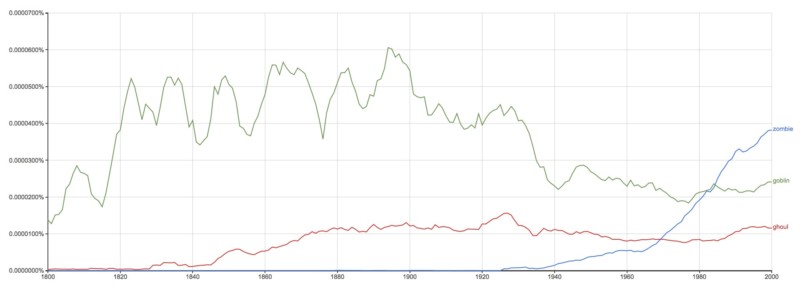Sign up for The Media Today, CJR’s daily newsletter.
Halloween is just around the corner, and you can bet that many people will be dressed as “zombies,” “ghouls,” and “goblins.” We’re willing to narrow that bet and say “zombies” will be more popular than the other two.
Our civilization seems to be obsessed with “zombies,” and has been for many years. Bela Lugosi starred in The White Zombie in 1932; The “Zombies” were a favorite rock band of the 1960s; we have “zombie” rules of grammar and “zombie” computers; and there’s even a “Zombie” wiki, which also lists hundreds of video games that include “zombies.” You have to be (forgive us) dead or brainless to miss all of the “zombie” references today.
ICYMI: A word that sounds dirty, but isn’t
But in English, “zombies” are relative newcomers, and they haven’t always eaten brains. In West African religions, a “zombie” was “a soulless corpse said to have been revived by witchcraft,” according to the Oxford English Dictionary, which states that the original “zombie” was a snake god. West African slaves brought their religion, known most popularly as voodoo, to Haiti and the American South, and the word “zombi” came into English in 1819, the OED says.
Until 1985, though, “zombies” in popular culture were generally just undead people who wandered around scaring (and killing) the living. But then came Return of the Living Dead, and brains became their primary food source.
TRENDING: The riskiest place in America to be a journalist
A quick look in newspaper archives shows how the popularity of “zombies” has zoomed in recent years. Between 1978, when Nexis started keeping track, to the end of the 1980s, “zombies” showed up about 1,000 times. They’ve shown up more than 700 times this year alone. So far. Yes, Nexis is tracking far more publications than it did at the beginning, but there’s no question that more zombies are awakening.
In fact, “zombies” have outpaced “ghouls” and “goblins” in popularity in books, as this Google n-gram shows.
“Ghouls” were originally evil spirits in Muslim countries that, according to the OED, were supposed to “rob graves and prey on human corpses.” “Ghoul” is derived from an Arabic word meaning “to seize,” and entered English in the late 18th century. Merriam-Webster says the original “ghouls” could change their shapes, but “had one unchanging feature: donkey’s hooves for feet.” It’s unclear whether the “ghouls” ate brains, though they did feed on those corpses.
The oldest of these three evil spirits in English is the “goblin,” which goes back to about 1325, the OED says, though it traces to third- or fourth-century France. A “goblin” isn’t dead, but is a “small, ugly, gnome-like creature of folklore, fairy tales, and fantasy fiction; in early use considered as malevolent or demonic, in later use often as merely mischievous,” as the OED puts it. More modern figurative use puts the emphasis on malevolence. In the 16th century, “goblins” became associated with Puck, also known as Robin Goodfellow, the sometimes-demonic sprite. One diminutive of “Robin” is “Hob,” so that particular spirit became known as a “hobgoblin.”
If you haven’t had enough of Halloween, check out our earlier “scary” guide to jack-o’-lanterns. For even more, here’s Grammarphobia’s tricked-out guide to all things haunting. It’s a treat.
ICYMI: News organization sets out ambitious Trump plan
Has America ever needed a media defender more than now? Help us by joining CJR today.




